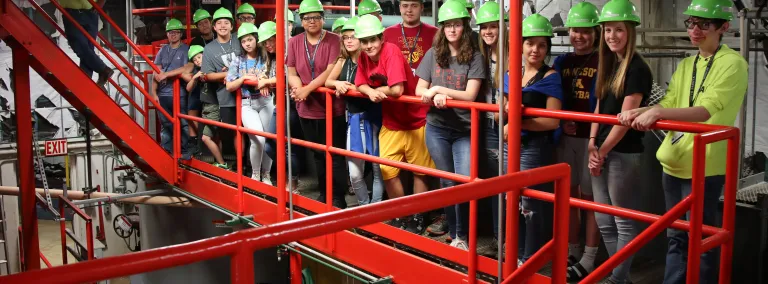Green Chemistry Camp tours award-winning WWTP facility
Camp seeks to instill an enthusiasm and appreciation of the role of chemistry in everyday life
Hundreds of gallons of water gush from the Wastewater Treatment Plant into Gold Run Creek every day, creating a waterfall that can be seen from the highway below. The water, pumped from the deepest drifts of the Sanford Lab and the tailing-laden reservoir of Grizzly Gulch, is filtered through multiple systems of advanced technology that clean dirt, minerals and toxins from the water, making it safe to return to natural stream systems.
On July 11, a group of ambitious high school students from across the United States toured the WWTP as a part of the Green Chemistry Camp hosted by the South Dakota School of Mines & Technology (SD Mines).
"Through hands-on experiments and discussions, this camp seeks to instill an enthusiasm and appreciation of the role of chemistry in everyday life and to promote a knowledgeable understanding of scientific issues," said Dr. Tsvetanka Filinova, director of the Green Chemistry Camp and senior lecturer of chemistry at SD Mines.
Since 2015, the program has hosted 52 students. This year, the average number of participants doubled, thanks to a $10,000 donation from the John T. Vucurevich Foundation. This donation provided scholarships to students from Pine Ridge Indian Reservation and the Cheyenne River Sioux Reservation.
“I’m honored to be accepted into the camp,” said Tia Lebeaux, a rising sophomore from Mobridge, S.D. “My science teacher, Mrs. Lindskov, knew that I enjoyed learning about chemistry and suggested I come to the camp. I loved making fuel cells out of water and using their hydrogen and oxygen to power them.”
The WWTP at Sanford Lab is a perfect example of environmentally responsible chemistry practices. Students received a tour of the facility, which exhibits green initiatives, including reduced waste, strategic energy and chemical usage, and computer automated monitoring and control systems.
Since Sanford Lab began operating in 2008, billions of gallons of water have been treated at the WWTP. More than half of that water is pumped from underground while the rest is added from the Grizzly Gulch tailings. Once treated, the water is released into Gold Run Creek, which joins Whitewood Creek within a few hundred yards of the discharge pipe.
Sanford Lab regularly monitors the health of the creeks, counting fish and macro invertebrate populations and tests for contaminants. In 2018, the WWTP was recognized for the tenth consecutive year by the South Dakota Department of Environment and Natural Resources (DENR) for their “outstanding operation of the wastewater system and environmental compliance” with DENR’s Surface Water Discharge Permit Award.
Ken Noren, foreman of the Wastewater Treatment Plant, described to the students some of the innovations the plant has adopted to reduce their operational waste,. “We’ve cut almost a thousand kilowatts of power at any given time across the plant and reduced our chemical usage (including coagulants and flocculants) from 300 gallons every two weeks to only 200 gallons a year.”
Throughout the week-long camp, students also participated in talks with local experts about multifaceted green initiatives including solar energy, biofuel fermentation, windmill generators and engineering challenges. The camp emphasized hands-on learning and enabled students to create their own water-based fuel cells and biodegradable plastics.
“It’s a great camp to learn new things,” said Jayshaun Morrisette, a rising freshman from Batesland, S.D. “I love any science that involves math, and you really get to see that here. I loved the hands-on experiments we are doing—it’s all new to me!”
The camp drew participants from across the United States. Margaret Todd, a rising senior from Smethport, P.A., who attended the program with her twin sister, Patricia, said, “I want to go into chemical engineering, and my sister wants to go into the medical field, so we are job shadowing in the Black Hills this summer. This program definitely steps up the science and has helped me understand what potential opportunities are out there for people studying chemistry.”
